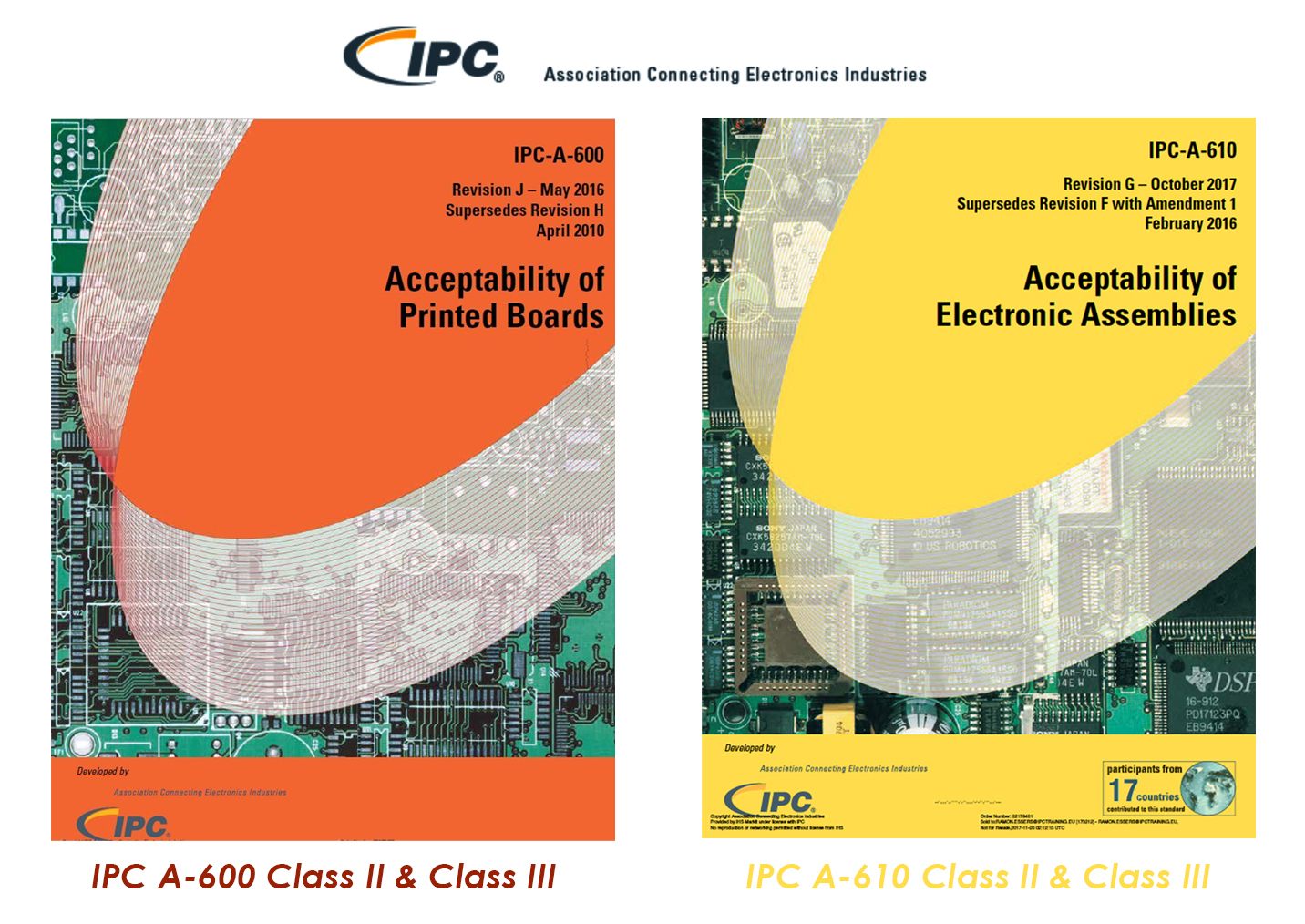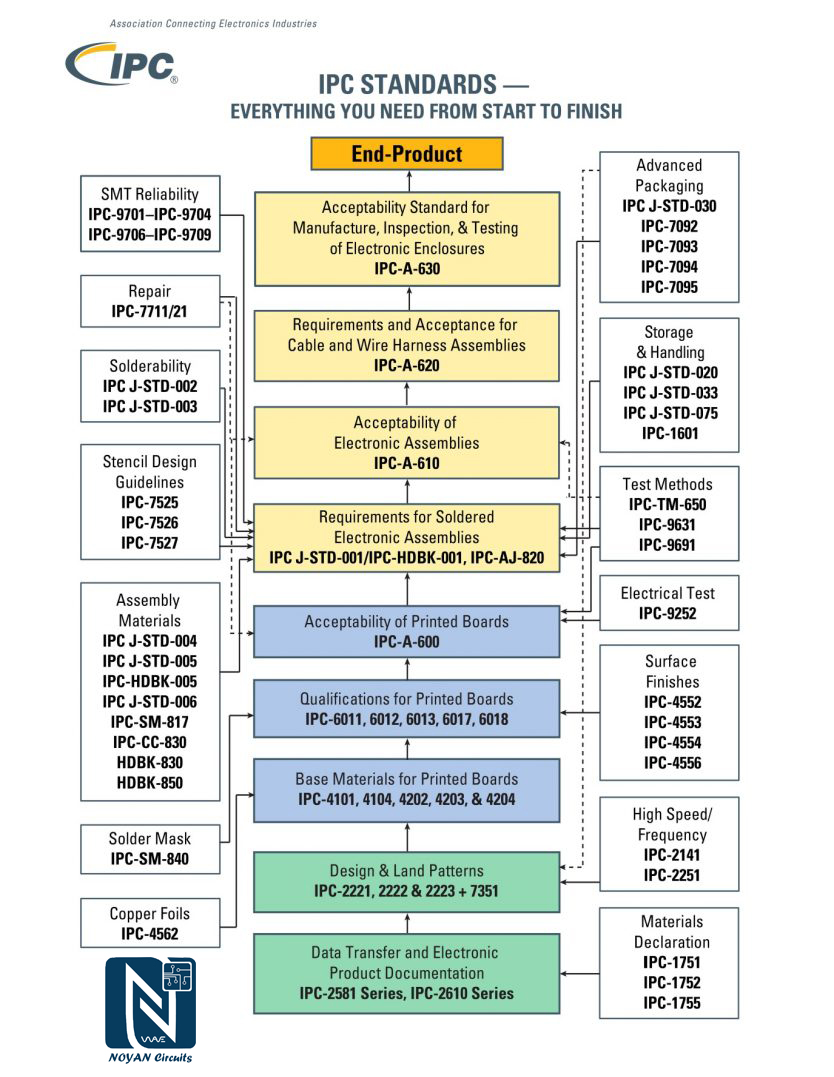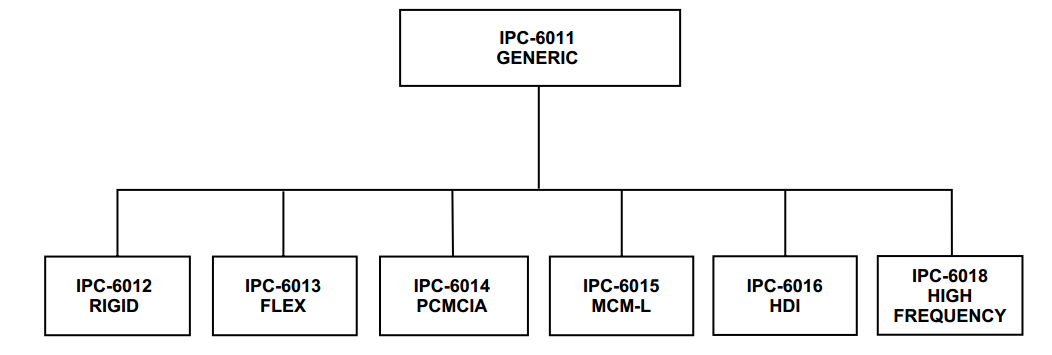
برد مدار چاپی نیز می بایست بر اساس کلیه معیارهای IPC (بر اساس هر کلاس بندی) ساخته شود. این معیارها شامل انتخاب فیبر مناسب، ضخامت آبکاری، متریال مناسب، فرایند تولید و معیارهای بازرسی می باشند. به علاوه این محصول می بایست در محیط مناسب و بر اساس سیستم کنترل کیفیت و برنامه پیوسته بهبود در طول فرایند ساخته شود و همچنین قابلیت ردیابی متریال های مود استفاده در سرتاسر فرایند ساخت را نیز داشته باشد. لازم به ذکر است که IPC در مرحله به مرحله ساخت و مونتاژ برد مدار چاپی، استانداردهای متفاوتی ارائه می دهد. در دیاگرام زیر از لحظه شروع طراحی تا اتمام ساخت و مونتاژ بردها، استانداردهای مربوطه ارائه شده است. همانطور که در دیاگرام بالا مشخص است در مرحله به مرحله تولید یک برد مدار چاپی می بایست استاندارد مربوطه رعایت شود. در بخش مستند سازی و طراحی برد مدارچاپی استاندارد های مربوطه ارائه می گردند و طراح می بایست بر اساس این استانداردها طراحی را انجام دهد و در مرحله بعد بر اساس استاندارد مربوطه فیبر مناسب را انتخاب نماید (به عنوان مثال برای بردهای سخت (Rigid) یک لایه یا چند لایه، استاندارد فیبر مناسب، IPC 4101 می باشد). لازم به ذکر است تا پایان این مراحل رعایت استانداردها بر عهده طراح می باشد. بعد از طراحی و انتخاب فیبر، سفارش ساخت برد می بایست انجام گیرد. در این مرحله که ساخت برد مدار چاپی آغاز می گردد، این بار سازنده برد مدار چاپی می بایست استاندارد های مربوطه را رعایت نماید. با توجه به نوع برد مدار چاپی (سخت، انعطاف پذیر، فرکانس بالا و ..) استانداردها متفاوت است. به عنوان مثال، استاندارد ساخت برد مدار چاپی نوع سخت (Rigid)، IPC 6012 می باشد. این استاندارد مشخصه های کیفیتی و عملکردی را در ساخت برد مشخص می کند و سازندگان برد های مدار چاپی می بایست بر طبق این استاندارد عمل نمایند. در کنار رعایت نمودناستاندارد IPC 6012 ، سازنده می بایست استاندارد مربوط به چاپ محافظ قلع کاری (Solder Mask) که IPC-SM-840 است و همچنین استاندارد پوشش نهایی سطح (Surface Finishes) (IPC 4552 برای پوشش الکترولس طلا) را نیز رعایت نماید. پس از اتمام این مراحل، بردهای ساخته شده می بایست تست الکتریکال را بر طبق استاندارد IPC 9252 پاس نمایند و همچنین بر طبق استاندارد IPC-A-600 ارزیابی گردند و این استاندارد را نیز پاس نمایند. به طور کلی IPC 6012 و IPC-A-600 برای بردهای مدار چاپی دو استاندارد ویژه هستند که به نوعی دست در دست یکدیگر عمل می کنند، به طوریکه IPC 6012 مشخصات، الزامات، کیفیت و عملکرد (دیداری، قابلیت لحیم کاری، ابعاد، عرض ترک ها و همچنین فاصله بین ترک ها، سطوح هادی، تمامیت ساختاری و تمیزی و …) مربوط به برد را مشخص می کند و IPC-A-600 به نوعی نماینده دیداری و بازرسی استاندارد IPC 6012 می باشد.
همانطور که در دیاگرام بالا مشخص است در مرحله به مرحله تولید یک برد مدار چاپی می بایست استاندارد مربوطه رعایت شود. در بخش مستند سازی و طراحی برد مدارچاپی استاندارد های مربوطه ارائه می گردند و طراح می بایست بر اساس این استانداردها طراحی را انجام دهد و در مرحله بعد بر اساس استاندارد مربوطه فیبر مناسب را انتخاب نماید (به عنوان مثال برای بردهای سخت (Rigid) یک لایه یا چند لایه، استاندارد فیبر مناسب، IPC 4101 می باشد). لازم به ذکر است تا پایان این مراحل رعایت استانداردها بر عهده طراح می باشد. بعد از طراحی و انتخاب فیبر، سفارش ساخت برد می بایست انجام گیرد. در این مرحله که ساخت برد مدار چاپی آغاز می گردد، این بار سازنده برد مدار چاپی می بایست استاندارد های مربوطه را رعایت نماید. با توجه به نوع برد مدار چاپی (سخت، انعطاف پذیر، فرکانس بالا و ..) استانداردها متفاوت است. به عنوان مثال، استاندارد ساخت برد مدار چاپی نوع سخت (Rigid)، IPC 6012 می باشد. این استاندارد مشخصه های کیفیتی و عملکردی را در ساخت برد مشخص می کند و سازندگان برد های مدار چاپی می بایست بر طبق این استاندارد عمل نمایند. در کنار رعایت نمودناستاندارد IPC 6012 ، سازنده می بایست استاندارد مربوط به چاپ محافظ قلع کاری (Solder Mask) که IPC-SM-840 است و همچنین استاندارد پوشش نهایی سطح (Surface Finishes) (IPC 4552 برای پوشش الکترولس طلا) را نیز رعایت نماید. پس از اتمام این مراحل، بردهای ساخته شده می بایست تست الکتریکال را بر طبق استاندارد IPC 9252 پاس نمایند و همچنین بر طبق استاندارد IPC-A-600 ارزیابی گردند و این استاندارد را نیز پاس نمایند. به طور کلی IPC 6012 و IPC-A-600 برای بردهای مدار چاپی دو استاندارد ویژه هستند که به نوعی دست در دست یکدیگر عمل می کنند، به طوریکه IPC 6012 مشخصات، الزامات، کیفیت و عملکرد (دیداری، قابلیت لحیم کاری، ابعاد، عرض ترک ها و همچنین فاصله بین ترک ها، سطوح هادی، تمامیت ساختاری و تمیزی و …) مربوط به برد را مشخص می کند و IPC-A-600 به نوعی نماینده دیداری و بازرسی استاندارد IPC 6012 می باشد.
هر کدام از این استانداردها در کلاس بندی های مختلفی تعریف می شوند که تعریف IPC از این کلاس بندی ها، بر اساس کاربرد و معیارهای کاربردی بردها می باشد و طراح مسئول این است که چه محصولی بر اساس چه کلاسی می بایست ساخته شود. طراح پس از مشخص نمودن کلاس محصول خود، از سازنده برد می خواهد که این محصول را بر اساس کلاس مربوطه تولید نماید. در ادامه این دسته بندی کلاس ها اراده می گردند.
چندین کلاس متفاوت برای محصولات طبق استاندارد IPC 6012 ارائه می گردند که عبارتند از:
کلاس 1:
محصولات الکترونیکی معمولی با طول عمر محدود و یک عملکرد ساده که قابلیت اطمینان پذیری خیلی بالایی از آن ها انتظار نمی رود، در این کلاس قرار می گیرند. بردهای مورد استفاده در دستگاه های کنترل از راه دور و چراغ قوه ها را می توان نمونه هایی از محصولاتی که در این کلاس قرار می گیرند، نام برد.
کلاس 2:
محصولات الکترونیکی اختصاصی که طول عمر بیشتری از آن ها انتظار می رود در این دسته قرار می گیرند. در این بردها اطمینان پذیری اهمیت بالایی دارد اما حیاتی نمی باشد. به طور کلی وسایلی که طول عمر و کارایی بالایی برای آن ها مد نظر است، اما خیلی ضروری نیست و وجود عیوب سطحی در این محصولات پذیرفته شده است، در این دسته قرار می گیرند. مادربورد لپ تاپ یا کامپیوتر و برد تلویزیون، نمونه هایی هستند که در این کلاس قرار می گیرند.
کلاس 3:
محصولاتی که اطمینان پذیری عملکردی آن ها باید بسیار بالا باشد در این کلاس قرار می گیرند. به عبارتی این کلاس شامل تجهیزات و محصولاتی می شود که کارایی مداوم دارند و این وسیله نمی تواند خاموش باشد، کاربرد این محصولات در صنایع نظامی و پزشکی با عملکرد حیاتی، می باشد. بردهای مورد استفاده در سیستم های کنترل پرواز و دستگاه تنظیم کننده ضربان قلب را می توان نمونه هایی از این کلاس بندی نام برد.
کلاس 3A/A:
استاندارد IPC 6012 این کلاس را مختص بردهای نظامی و صنایع هوایی اویونیک ارائه کرده است و به نوعی محصولات نظامی را از کلاس قبل خارج و بطور ویژه در این کلاس به آن ها می پردازد.
البته این نکته را نیز می بایست در نظر گرفت که در یک مجموعه ممکن است ترکیبی از همه کلاس ها مورد استفاده قرار گیرند. به عنوان مثال، در یک هواپیما ممکن است تجهیزاتی وجود داشته باشد که هر کدام بر اساس کلاس بندی مختلفی می باشند و به نوعی می تواند کلاس 2 و یا حتی کلاس 1 نیز وجود داشته باشد.
حال با در نظر گرفتن این کلاس بندی ها می توان این طور بیان نمود که IPC-A-600 در حقیقت سطح قابل پذیرش برای هر کلاس از محصول را مشخص می نماید. به عبارت دیگر این استاندارد در بردهای مدار چاپی، هدف، معیارهای قابل پذیرش و شرایط غیرمنتظره را که می تواند خارجی و هم داخلی باشد، را توصیف می نماید. می توان گفت این استاندارد تفسیر بصری از حداقل الزامات برای مشخصه های بردهای مدار جاچی، مثل سری IPC-6010، را ارائه می دهد. در ادامه استاندارد سری 6010 معرفی می گردد.
ACCEPTABILITY/QUALIFICATIONS FOR PRINTED BOARDS IPC-6010-Series
Family of Board Performance Requirements — includes 7 documents This series includes IPC’s current qualification and performance specification standards for all major types of printed boards, including:
• IPC 6011, Generic Performance Specification for Printed Boards
• IPC 6012, Qualification and Performance Specification for Rigid Printed Boards
• IPC 6013, Qualification and Performance Specification for Flexible Printed Boards
• IPC 6015, Qualification & Performance Specification for Organic Multi chip Module (MCM-L) Mounting & Interconnecting Structures
• IPC 6016, Qualification and Performance Specification for High Density Interconnect (HDI) Layers or Boards
• IPC 6018, Qualification and Performance Specification for High Frequency (Microwave) Printed Boards

See below for complete descriptions of the included documents.
IPC 6011
Generic Performance Specification for Printed Boards
This specification establishes the general requirements and responsibilities for suppliers and users of printed boards. Serving as the foundation for the IPC-6010 Board Performance Requirements series, IPC-6011 describes quality and reliability assurance requirements that must be met.
Formats: H, C, D, S
IPC 6012
Qualification and Performance Specification for Rigid Printed Boards
This specification covers qualification and performance of rigid printed boards, including single sided, double-sided, with or without plated-through holes, multi-layer with or without blind/buried vias, and metal core boards. It addresses final finish and surface plating coating requirements, conductors, holes/vias, frequency of acceptance testing and quality conformance as well as electrical, mechanical and environmental requirements. Other requirements covered are surface finishes, hole plating thickness, meas ling, weave exposure, copper cap plating of filed holes, laminate cracks and voids, etch back, blind and buried via fill, acceptance testing and frequency, and requirements for thermal stress testing.
Formats: H, C, D, K, S, G
IPC 6013
Qualification and Performance Specification for Flexible Printed Boards
Covers qualification and performance requirements for flexible printed boards designed to IPC-2221 and IPC-2223. The flexible printed board may be single-sided, double-sided, multi-layer or rigid-flex multi-layer. All of these constructions may include stiffeners, plated-through holes (PTH) and blind/ buried vias. Additional requirements for surface plating, measles, foreign inclusions, adhesive squeeze-out, solder-able annular ring, PTH copper wrap, plating folds, micro section evaluations, acceptance testing frequency and more are covered.
Formats: H, C, D, K, S, G
IPC 6015
Qualification & Performance Specification for Organic Multi-chip Module (MCM-L) Mounting & Interconnecting Structures
This standard establishes the specific requirements for organic mounting structures used to interconnect chip components which in combination form the completed functional organic single-chip module (SCM-L) or organic multi-chip module (MCM-L) assembly. Includes the quality and reliability assurance requirements that must be met for their acquisition.
Formats: H, C, D, S, G
IPC 6016
Qualification and Performance Specification for High Density Interconnect (HDI) Layers or Boards
IPC 6017
Qualification and Performance Specification for Printed Boards Containing Embedded Passive Devices
This new standard supplements existing IPC-6010 series specifications with qualification and performance requirements for in-process and finished printed boards Containing embedded passive circuitry (distributive capacitive planes and capacitive or resistive components.
Formats: H, C, D, K, S, G
IPC 6018
Qualification and Performance Specification for High Frequency (Microwave) Printed Boards
Establishes requirements for qualification and performance of high frequency (microwave) printed boards. Covers both end product inspection and test of microwave boards for microstrip, stripline, mixed dielectric and multi-layer stripline applications. It addresses final finish and surface plating coating requirements, conductors, holes/vias, and frequency of acceptance and quality conformance testing, as well as electrical, mechanical and environmental requirements. Surface finishes, microvia requirements including hole plating thickness and copper wrap/cap plating of filed holes, laminate cracks and voids, etch back, PTFE resin smear, and thermal stress testing can be found in the standard.
Formats: H, C, D, K, S, G
IPC-A-600
Acceptability of Printed Boards
The definitive illustrated guide to printed board acceptability! This four-color document includes photographs and illustrations of the target, acceptable and nonconforming conditions that are either internally or externally observable on bare printed boards. Make sure your operators, inspectors and engineers have the most current industry consensus information. Additional topics covered are copper wrap plating, copper cap plating of filed holes, and hole wall/barrel separation along with updated and expanded coverage for measling of printed boards, delamination and haloing, laminate voids/cracks, etch back, blind and buried via fil, and flexible circuits. The document synchronizes to the acceptability requirements expressed in IPC-6012 and IPC-6013.
Formats: H, C, D, K, S, G
در رابطه با مونتاژ برد مدار چاپی لطفاً توجه نمایید که کلاس عملکرد نهایی برای مونتاژ برد مدار چاپی (PCBA) نمی تواند بهتر از کلاس عملکردی برای تولید برد مدار چاپی (PCB) باشد. یعنی برای محقق نمودن کلاس 3 در مونتاژ، باید برد مدار چاپی نیز بر اساس کلاس 3 ساخته شود.
البته عموماً استاندارد تولید برد مدارچاپی (PCB) به صورت پیش فرض IPC-A-600 Class II و استاندارد پیش فرض مونتاژ برد مدار چاپی (PCBA)، IPC-A-610 Class II می باشد.
**نویان مدار قادر است با توجه به نیاز مشتریان، بردهای مدارچاپی را بر طبق استاندارد IPC-A-600 در دو کلاس 2 و 3، با ارائه مستندات تست و گواهی پاس نمودن این استاندارد برای هر برد، ارائه نماید.
در ادامه تعدادی از استاندارد های فیبر های مورد استفاده، پوشش های نهایی سطح، چاپ مجافظ قلع کاری که در ساخت و مونتاژ بردهای مدار چاپی استفاده می گردند، ارائه شده اند.
Base Material Boards
IPC-4101
Specification for Base Materials for Rigid and Multilayer Printed Boards
This specification covers the requirements for base materials that are referred to as laminate or prepreg. These are to be used primarily for rigid and multi-layer printed boards for electrical and electronic circuits. This document contains individual specification sheets that can be searched using keywords
IPC-4103
Specification for Base Materials for High Speed/High Frequency Applications
This specification covers the requirements for clad and unclad plastic laminate and bonding layer materials to be used for the fabrication of printed boards for microstrip, stripline, and high speed digital electrical and electronic circuit Also included are testing parameters, inspection lot requirements, visual acceptance criteria, specification sheet format for new materials that provides both mandatory (e.g., Df and Dk) requirements as well as “loose” requirements (e.g., thermal conductivity and moisture absorption) that can be certified to or called out on fabrication drawings
IPC-4104
IPC/JPCA Specification for High Density Interconnect (HDI) and Microvia Materials
IPC-4202
Flexible Base Dielectrics for Use in Flexible Printed Circuitry
This document provides comprehensive data to help users determine both material capability and compatibility of flexible base dielectric materials of flexible printed circuitry and flexible flt cables. It includes flexible base material specification sheets with the newest properties for specification material types. It establishes the most current classification system, qualification and quality conformance requirements, including high frequency dielectric properties
Surface Finished
IPC-4552
Specification for Electroless Nickel/Immersion Gold (ENIG) Plating for Printed Circuit Boards
IPC-4553
Specification for Immersion Silver Plating for Printed Circuit Boards
IPC-4554
Specification for Tin Plating for Printed Circuit Boards – Amendment 1
IPC-4556
Specification for Electroless Nickel/ Electroless Palladium/Immersion Gold (ENEPIG) for Printed Circuit Boards
Solder Mask
IPC-SM-840
Qualification and Performance Specification of Permanent Solder Mask and Flexible Cover Materials
Establishes the requirements for the evaluation of liquid and dry film solder mask material and for the determination of the acceptability of use on a standard printed board system. The standard provides two classes of requirements to reflect functional performance requirements and testing severity based on industry/end-use requirements. It covers adhesion, material qualification, resistances to solvents and electrical requirements.
Electronics Assembly Acceptability
IPC-A-610
Acceptability of Electronic Assemblies
IPC-A-610 is the most widely used electronics assembly standard in the world. A must for all quality assurance and assembly departments, IPC-A-610 illustrates industry-accepted workmanship criteria for electronic assemblies with full-color photographs and illustrations. Topics include flux attachment; board in board; part on part; lead free; component orientation and soldering criteria for through-hole, SMT (new termination styles) and discrete wiring assemblies; mechanical assembly; cleaning; marking; coating; and laminate requirements. This document synchronizes to other industry consensus documents and is used with the material and process standard IPC J-STD-001.
Formats: H, C, D, K, S, G